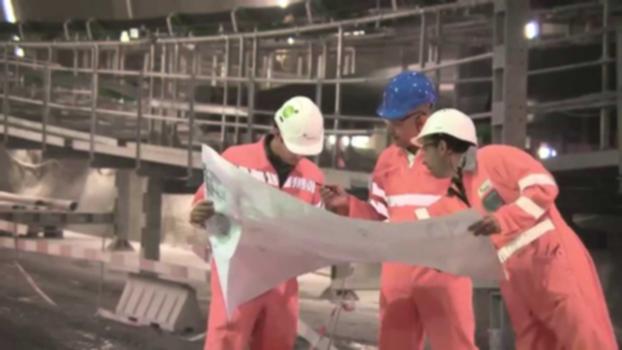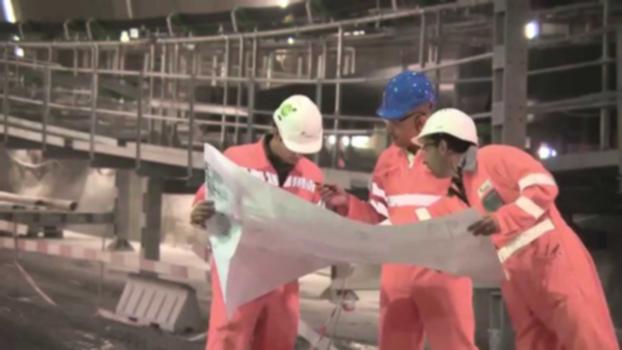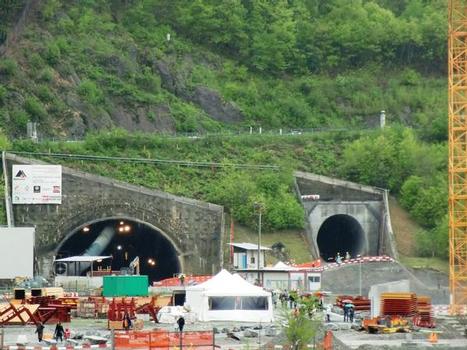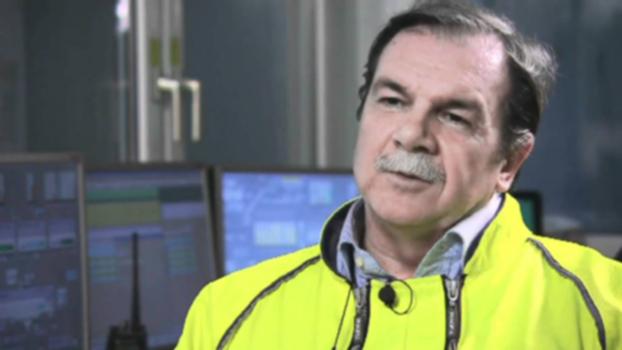General Information
Project Type
| Structure: |
Tunnel |
|---|---|
| Function / usage: |
Railroad (railway) tunnel |
Location
| Location: |
Camorino, Tessin, Switzerland Vezia, Tessin, Switzerland |
|---|---|
| Part of: | |
| Coordinates: | 46° 1' 41.18" N 8° 56' 7.16" E |
| Coordinates: | 46° 9' 22.40" N 8° 59' 10.72" E |
Technical Information
Dimensions
| number of tubes | 2 | |
| tube 1 | length | 15 475 m |
| tube 2 | length | 15 316 m |
Case Studies and Applied Products
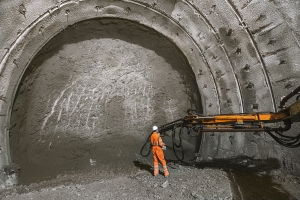
Ceneri Base Tunnel – Switzerland’s third longest railway tunnel
The Ceneri Base Tunnel (CBT) in the canton of Ticino is the third longest railway tunnel in Switzerland. It is the continuation of the Gotthard Base Tunnel along a new transalpine railway line that has a tot ... [more]
Chronology
| 4 September 2020 | Inauguration |
|---|
Excerpt from Wikipedia
The Ceneri Base Tunnel (CBT) is a railway base tunnel under construction in Switzerland's Canton Ticino. It passes under Monte Ceneri between Camorino in the Magadino Flat and Vezia near Lugano, and will bypass the current high-altitude rail route through the Monte Ceneri Tunnel. It is composed of two single-track tunnels, each 15.4 km (9.6 mi) long. It is another part of the New Railway Link through the Alps (NRLA) project. The final breakthroughs took place on 21 January 2016 (west tube) and 26 January 2016 (east tube). The tunnels are now being equipped and rail service is expected to start in December 2020.
An exploration tunnel near Sigirino was excavated between 1999 and 2003 to gain geological data on the rock formations at the Ceneri Base Tunnel's level. Based on those data, it was decided to only drill a small part using a tunnel boring machine (TBM) while the rest was excavated with traditional blasting methods. Both the CBT and Gotthard Base Tunnels are being built under contract from the Swiss Federal Government by Alptransit Gotthard AG. Construction of the two single-track bores started during March 2006. The official start of the CBT's construction phase was celebrated on 2 June 2006 with the laying of a foundation stone.
On completion, the Ceneri Base Tunnel will become an important southern feeder for the Gotthard Base Tunnel as the existing, proportionally steep track over Monte Ceneri is not suitable for high-speed rail or heavy freight trains. Another feeder is the Luino link along Lake Maggiore which is about to be upgraded by Italy in prospect of the opening of the Gotthard Base Tunnel. Both links meet in the Magadino Flat in the future Camorino Node (Italian:Nodo di Camorino). The CBT will ease local train traffic, mainly between the two major cities Locarno and Lugano but also between Bellinzona and Lugano. Travel time on the S-Bahn from Locarno to Lugano should drop from 50 to 22 minutes.
History
Background
The Ceneri Base Tunnel is a Swiss railway base tunnel under construction through Monte Ceneri between Camorino in the Magadino Flat and Vezia near Lugano, which shall allow traffic to bypass the conventional high-level railway running through the historic Monte Ceneri Tunnel. It forms only one element of a wider effort, commonly referred to as the New Rail Link through the Alps (NRLA) programme, which is being developed by AlpTransit Gotthard AG (ATG), a wholly owned subsidiary of the Swiss Federal Railways (SBB). Once completed, the Ceneri Base Tunnel and the longer Gotthard Base Tunnel shall work together to provide significantly shorter journey times between the northern city of Zurich and the Northern Italian city of Milan by providing a flatter route for freight trains than conventional lines have previously allowed for.
In total, the Ceneri Base Tunnel carries a pair of parallel bores, each containing a single-track, set 40 meters apart from one another and connected by cross passages at evenly spaced intervals of 325 meters. Stretching between the towns of Camorino and Vezia, it possesses a total length of 39.78km; the eastern bore has a length of 15.45km and the west bore is 15.28km long. An operations center controlling ventilation and logistical activities has been constructed at Sigirino. Operationally, the Ceneri Base Tunnel has been anticipated to be used by in excess of 300 trains each day travelling in both directions. It shall be furnished with ETCS Level 2 signalling, allowing for trains to traverse it at speeds of up to 250 km/h. For handling emergency situations in the Ceneri Base Tunnel, the Swiss Federal Railways has acquired a fleet of dedicated rescue trains; these are equipped with specialised fire fighting equipment and other useful facilities, such as independent air supplies.
During July 2001, the proposed Ceneri Base Tunnel was approved by the Swiss Federal Council, clearing the way for detailing planning and eventual construction activity to proceed. Further Parliamentary approval of the selected route for the tunnel was received in 2003, and the first funding towards construction was released during 2005. During April 2007, AlpTransit Gotthard AG awarded a Sfr85m ($91.52m) contract for the construction of the first underground element of the tunnel to Consorzio Monte Ceneri (CMC) JV, a consortium of CSC, Lugano, Frutiger, Thun, Rothpletz, Lienhard & Cie, and Aarau. During June 2009, the Board of Directors of AlpTransit Gotthard AG announced that it had awarded the principal contract for the tunnel's construction to the Consorzio Condotte Cossi consortium. At the time, the tunnel is expected to be operational by December 2020. This contract was valued at Sfr987 million ($1.6 billion). The estimated total cost for the Ceneri Base Tunnel is Sfr2.4 billion ($2.58 billion).
Construction
During June 2006, construction work on the tunnel officially commenced. In November 2008, the excavation of a 2.4km-long (1.5 miles) adit tunnel was completed, it involved the excavation of 160,000m³ of hard rock. A tunnel boring machine (TBM), provided by Robbins Company and equipped with 483mm cutters, was used to bore the adit tunnel over the course of ten months during which it advanced at a rate of 18.5 meters per day. During the spring of 2010, work commenced upon the boring of the Ceneri Base Tunnel itself. During March 2010, it was announced that blasting had begun on the main drives of the twin-bores. By the end of the year, the rate of tunneling had reportedly attained its full speed. A combination of conventional drilling and blasting techniques were used to bore approximately 37.49km of the tunnel, while the remainder was bored using a tunnel boring machine TBM.
Breakthrough in the west tube between Sigirino and Vezia occurred on 17 March 2015. Breakthrough in the east tube between Sigirino and Vezia occurred on 30 March 2015. On 21 January 2016, breakthrough was achieved in the west bore between Sigirino and Vigana, while the breakthrough in the east bore between Sigirino and Vigana occurred on 26 January 2016. That same day, it was announced that the excavation process had been completed, and the installation of railway infrastructure was the next major stage of the work. During February 2017, the final concrete block was placed in a ceremony marking the tunnel becoming structurally complete.
During August 2013, the Mons Ceneris Consortium, headed by Mancini & Marti, was awarded a Sfr96 million ($103.36 million) contract to provide railway track and logistics for the tunnel. That same month, the Cablex-led CPC Consortium won a Sfr129 million ($138.89 million) contract to provide railway systems and overall tunnel co-ordination services. The planning, supply, installation and commissioning of the tunnel control systems, which are to be controlled from a control centre at Pollegio, has been contracted to Tunnel Control Systems. The awarding of these contracts was not without controversy; a pair of appeals were subsequently upheld by the Federal Supreme Court of Switzerland regarding the awarding process. At one point, it looked as if completion of the Ceneri Base Tunnel may be delayed as a consequence of legal disputes. However, the dispute was settled during September 2014, which unblocked the awarding of contracts as well as allowing for work to proceed.
During 2017, the installation of this infrastructure, such as the track, catenary, electrical supply cables, telecommunications and radio systems, and various safety and control systems commenced. During August 2017, the first sections of ballastless track were laid in the northern end of the eastern bore. On May 30, 2018, the final railroad tie was laid, meaning that trains can now travel the entire length of the tunnel.
Text imported from Wikipedia article "Ceneri Base Tunnel" and modified on 22 July 2019 under the CC-BY-SA 3.0 license.
Participants
Relevant Web Sites
Relevant Publications
- (1999): Besonderheiten der Planung und Abwicklung der Eisenbahntunnel am Gotthard. In: Felsbau, v. 17, n. 5 ( 1999), pp. 321-328.
- (2006): Caduto il primo diaframma nella galleria del San Gottardo. In: Strade e Autostrade, v. 10, n. 60 (November 2006), pp. 74.
- (2018): The Ceneri Base Tunnel: Construction Experience with the Southern Portion of the Flat Railway Line Crossing the Swiss Alps. In: Engineering, v. 4, n. 2 (April 2018), pp. 235-248.
- (2008): Der Ceneri-Basistunnel. In: TEC21, v. 134, n. 41 (6 October 2008).
- (2012): Construction of a cavern under an autobahn embankment for the Ceneri Base Tunnel / Unterquerung eines Autobahndamms durch eine Kaverne beim Ceneri-Basistunnel. In: Geomechanics and Tunnelling, v. 5, n. 2 ( 2012), pp. 175-185.
- About this
data sheet - Structure-ID
20000905 - Published on:
06/09/2000 - Last updated on:
28/05/2021

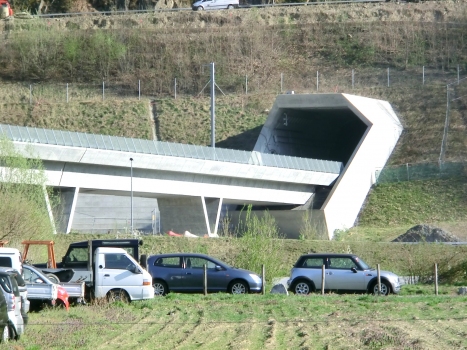
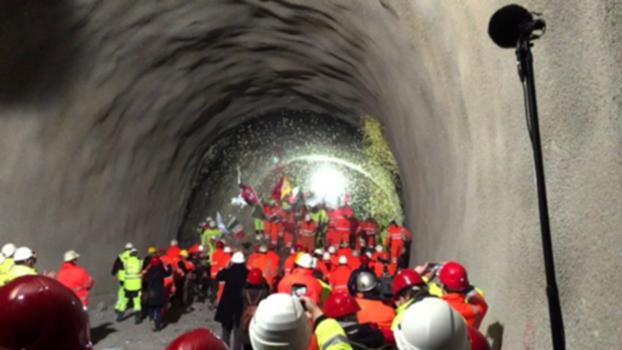
![Ceneri-Tunnel: Nord und Süd begrüssen sich - Ceneri - Basistunnel - Durchstich - Jubel - Neat : Camorino - 21.01.2016 - Nach dem Hauptdurchschlag im Ceneri-Basistunnel begrüssen sich die Nord- und Südseite und feiern ihren Erfolg. Das Tessin freut sich auf den neuen Tunnel, sieht es aber als Gewinn für die ganze Schweiz.
Sie wollen dieses Video in Ihren Produkten verwenden? Melden sie sich bei uns:
video[at]keystone.ch
http://www.keystone.ch
---------------------
Interested in using this video in your products? Contact us:
video[at]keystone.ch
http://www.keystone.ch](https://files.structurae.net/files/350high/video/369527.jpg)
